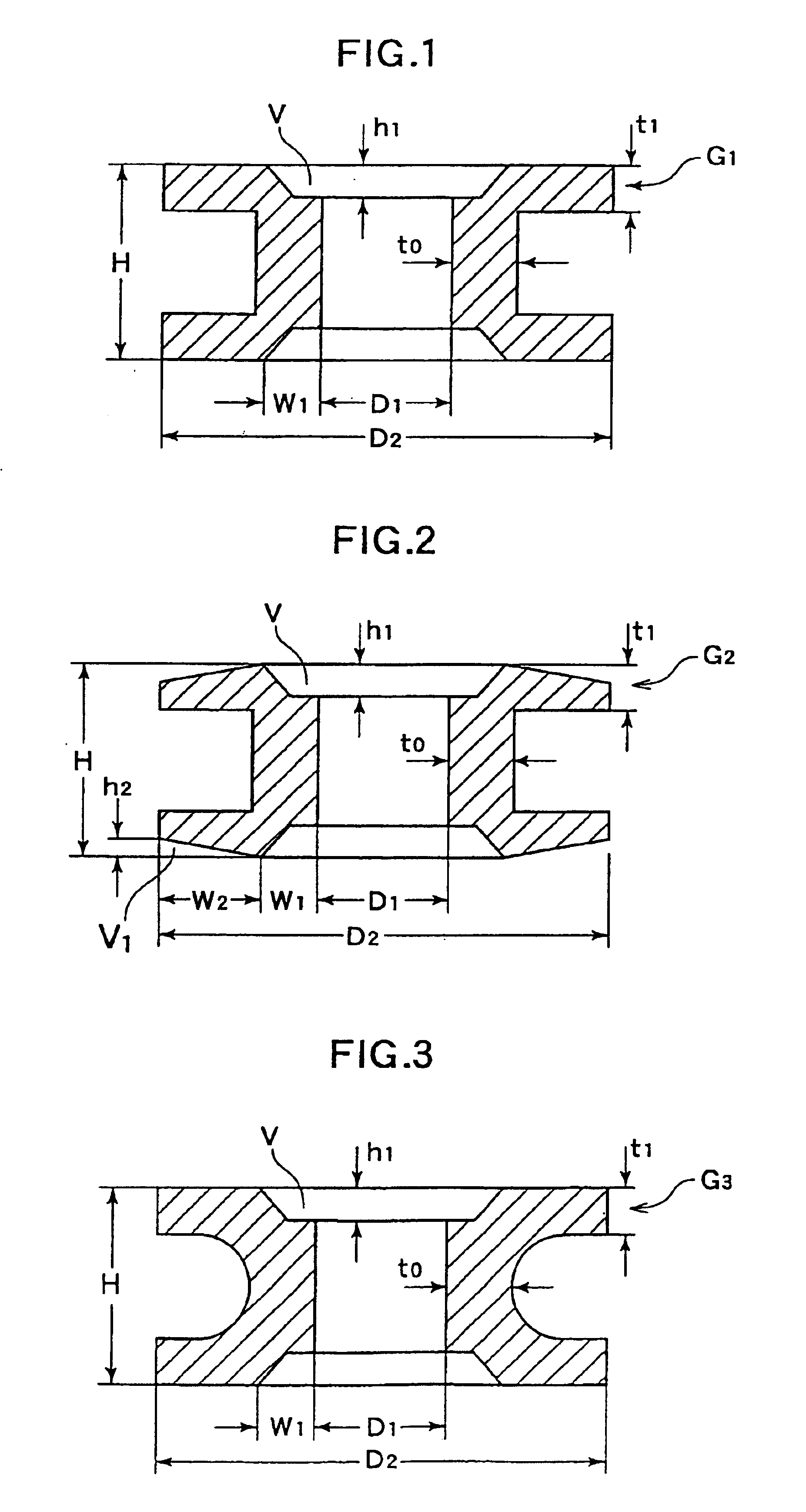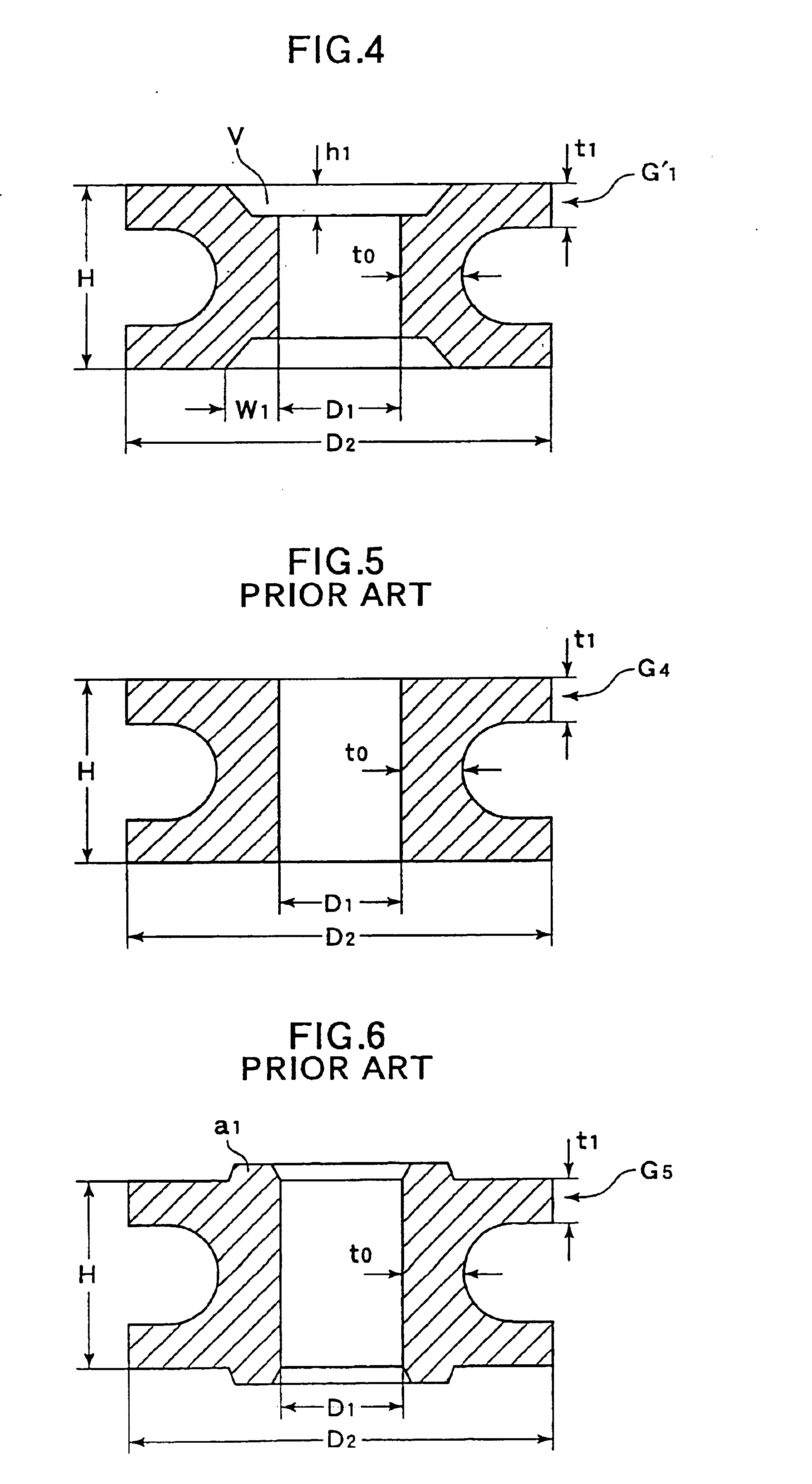Metal gasket
a technology of metal gaskets and gaskets, applied in the direction of fluid pressure sealing joints, engine seals, pipes, etc., can solve the problems of leakage at the welded portion, decreased thickness, and difficulty in bending and welding, and achieve the effect of small tightening for
- Summary
- Abstract
- Description
- Claims
- Application Information
AI Technical Summary
Benefits of technology
Problems solved by technology
Method used
Image
Examples
embodiment 1
[0041]In an embodiment 1, a round metal bar made of SUS 316L and having an outside diameter of 8.0 mm was cut to a length of 1.7 mm, and a metal gasket G1 as shown in FIG. 1 was obtained by cutting the metal bar. The gasket was formed to have a C-shaped cross section and had an outside diameter D2 of 7.2 mm, an inside diameter D1 of 4.6 mm, a height H of 1.60 mm, a the bight section having a central wall thickness t0 of 0.56 mm, and a wall thickness t1 of 0.33 mm in the portions thereof in contact with opponent surfaces. Further, the gasket had voids V each having a trapezoidal cross section and formed to the innermost circumferential portions of the two sealing surfaces thereof in contact with flanges. Each void V had a width w1 of 0.33 mm, a height h1 of 0.11 mm and an area S of 0.03 mm2. Thereafter, the metal gasket G1 was subjected to annealing and electrolytic polishing, thereby the gasket having surface hardness of 200 Hv was obtained.
embodiment 2
[0042]In an embodiment 2 which was made by the same method as that of the embodiment 1, a round metal bar having an outside diameter of 8.0 mm was cut to a length of 1.7 mm, and a metal gasket G2 as shown in FIG. 2 was obtained by cutting the metal bar. The gasket was formed to have a U-shaped cross section and had an outside diameter D2 of 7.2 mm, an inside diameter D1 of 4.6 mm, a height H of 1.60 mm, the bight section having a central wall thickness t0 of 0.56 mm, and a wall thickness t1 of 0.33 mm in the portions thereof in contact with opponent surfaces. Further, the gasket G2 had voids V each having a trapezoidal cross section and formed to the innermost circumferential portions of the two sealing surfaces thereof in contact with flanges. Each void V had a width w1 of 0.33 mm, a height h1 of 0.11 mm and an area S of 0.03 mm2. Furthermore, the gasket G2 had voids V1 each having a triangular cross section and formed toward the outer circumferences of the two sealing surfaces in ...
embodiment 3
[0043]In an embodiment 3 which was made by the same method as that of the embodiment 1, a round metal bar having an outside diameter of 8.0 mm was cut to a length of 1.7 mm, and a metal gasket G3 as shown in FIG. 3 was obtained by cutting the metal bar. The gasket was formed to have a U-shaped cross section and had an outside diameter D2 of 7.2 mm, an inside diameter D1 of 4.6 mm, a height H of 1.60 mm, the bight section having a central wall thickness to of 0.56 mm, and a wall thickness t1 of 0.33 mm in the portions thereof in contact with opponent surfaces. The gasket G3 had voids V each having a trapezoidal cross section and formed to the innermost circumferential portions of the two sealing surfaces thereof in contact with flanges. Each void V had a width w1 of 0.33 mm, a height h1 of 0.11 mm and an area S of 0.03 mm2. Thereafter, the metal gasket G3 was subjected to annealing and electrolytic polishing, thereby the gasket having surface hardness of 200 Hv was obtained.
PUM
 Login to View More
Login to View More Abstract
Description
Claims
Application Information
 Login to View More
Login to View More - R&D
- Intellectual Property
- Life Sciences
- Materials
- Tech Scout
- Unparalleled Data Quality
- Higher Quality Content
- 60% Fewer Hallucinations
Browse by: Latest US Patents, China's latest patents, Technical Efficacy Thesaurus, Application Domain, Technology Topic, Popular Technical Reports.
© 2025 PatSnap. All rights reserved.Legal|Privacy policy|Modern Slavery Act Transparency Statement|Sitemap|About US| Contact US: help@patsnap.com



